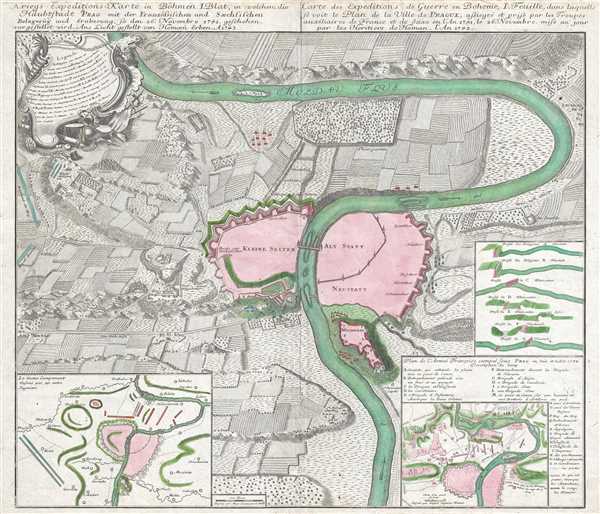1743 Homann Heirs Map of the 1741 Battle of Prague (Praha)
FrenchSiegeofPrague-homannheirs-1743
Title
1743 (dated) 20.5 x 23.5 in (52.07 x 59.69 cm) 1 : 21000
Description
The Battle of Prague – November 1741
The War of the Austrian Succession was fought over the question of Maria Theresa's succession to the Habsburg Monarchy. During the war, the Prussians invaded Silesia with the goal of annexing that territory. France, fearful that the Prussians would gain incredible amounts of territory, entered the war on the Prussian side in support of the claim of Elector Charles Albert of Bavaria to the Austrian thrown. Supported by Bavarian and Saxon soldiers, the French army initially marched on Vienna before abruptly changing course and invading Bohemia. This column, which the Austrians could not find, advanced on Prague, the capital of Bohemia. Led by the intelligent and experienced Maurice de Saxe, he and a small party reconnoitered Prague and were able to recognize where they had an advantage. Saxe sent his most competent (and boldest) officer, Colonel François de Chevert, to assault the walls at night. During the night of 25-26 November, Chevert and his men employed ladders to scale a parapet and capture a section of the walls. They then opened the Prague's gate for Saxe's cavalry, leaving the city's defenders no choice but surrender.
This map was drawn by Lieutenant Meyer of the Artillery, and the inset map in the lower right was drawn by a French engineer named Sinsart. The whole was compiled and published by Homann Heirs in 1743.
Cartographer
Homann Heirs (1730 - 1848) were a map publishing house based in Nuremberg, Germany, in the middle to late 18th century. After the great mapmaker Johann Baptist Homann's (1664 - 1724) death, management of the firm passed to his son Johann Christoph Homann (1703 - 1730). J. C. Homann, perhaps realizing that he would not long survive his father, stipulated in his will that the company would be inherited by his two head managers, Johann Georg Ebersberger (1695 - 1760) and Johann Michael Franz (1700 - 1761), and that it would publish only under the name 'Homann Heirs'. This designation, in various forms (Homannsche Heirs, Heritiers de Homann, Lat Homannianos Herod, Homannschen Erben, etc..) appears on maps from about 1731 onwards. The firm continued to publish maps in ever diminishing quantities until the death of its last owner, Christoph Franz Fembo (1781 - 1848). More by this mapmaker...

